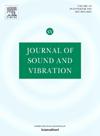Crowdsensing-based bridge vibration monitoring using a sparse network of random mobile sensors: Theory and numerical verifications
IF 4.3
2区 工程技术
Q1 ACOUSTICS
引用次数: 0
Abstract
Vibration monitoring of bridges is essential for the safety and maintenance of transportation infrastructure. Traditional methods rely on placing sensors directly on bridges, a process that is often costly and difficult to scale. An emerging alternative involves utilizing sensors mounted within vehicles as they traverse the bridge. However, this approach often faces challenges with continuous monitoring due to the limited time vehicles spend on the structure. This paper presents a novel framework for predicting bridge responses and identifying its modal characteristics through the crowdsensing of sparse vibration data from a network of vehicles traversing the bridge. The framework employs vehicles’ body accelerations and positional data to estimate bridge responses at distributed virtual fixed sensing nodes (VFSNs). By randomly selecting some vehicles as sensing agents at sequential timestamps, it ensures a reliable and continuous flow of data. Additionally, the framework mitigates the influence of road roughness and vehicle dynamics by utilizing residual contact-point responses between the rear and front axles of the sensing vehicles. Simulations of a three-span bridge under realistic traffic conditions, including road roughness and vehicle–bridge interaction, were conducted to validate the framework’s accuracy. Despite an 80% data missing rate and relying on only two sensing agents along with 17 VFSNs, the framework successfully identified the first three modes of the bridge with MAC values above 95% and natural frequencies with relative errors below 3%. Response predictions showed an accuracy exceeding 70%. Various factors were investigated, including traffic speed, the number of sensing agents and VFSNs, ambient noise effects, and the impact of the random vehicle selection process. The results confirmed the robustness of the framework against ambient noise and randomness in sensing agent selection. The optimal configuration was identified as two sensing agents and 17 VFSNs.
基于人群感知的随机移动传感器稀疏网络桥梁振动监测:理论与数值验证
桥梁振动监测对交通基础设施的安全和维护至关重要。传统的方法依赖于将传感器直接放置在桥上,这一过程通常成本高昂且难以扩展。一种新兴的替代方案是在车辆通过桥梁时利用安装在车辆内部的传感器。然而,由于车辆在结构上花费的时间有限,这种方法经常面临连续监测的挑战。本文提出了一种新的框架,通过对通过桥梁的车辆网络的稀疏振动数据的群体感知来预测桥梁的响应并识别其模态特征。该框架利用车辆的车身加速度和位置数据来估计分布式虚拟固定传感节点(VFSNs)上的桥梁响应。通过在连续的时间戳上随机选择一些车辆作为感知代理,保证了数据流的可靠和连续。此外,该框架通过利用传感车辆后轴和前轴之间的残余接触点响应,减轻了道路粗糙度和车辆动力学的影响。在实际交通条件下对一座三跨桥梁进行了仿真,包括道路粗糙度和车桥相互作用,以验证该框架的准确性。尽管有80%的数据缺失率,并且仅依赖于两个传感代理和17个VFSNs,该框架成功地识别了桥梁的前三种模式,MAC值高于95%,固有频率相对误差低于3%。反应预测的准确率超过70%。研究了各种因素,包括交通速度、感知代理和VFSNs的数量、环境噪声影响以及随机车辆选择过程的影响。结果证实了该框架对环境噪声和感知代理选择随机性的鲁棒性。确定了最优配置为2个传感体和17个vfsn。
本文章由计算机程序翻译,如有差异,请以英文原文为准。
求助全文
约1分钟内获得全文
求助全文
来源期刊

Journal of Sound and Vibration
工程技术-工程:机械
CiteScore
9.10
自引率
10.60%
发文量
551
审稿时长
69 days
期刊介绍:
The Journal of Sound and Vibration (JSV) is an independent journal devoted to the prompt publication of original papers, both theoretical and experimental, that provide new information on any aspect of sound or vibration. There is an emphasis on fundamental work that has potential for practical application.
JSV was founded and operates on the premise that the subject of sound and vibration requires a journal that publishes papers of a high technical standard across the various subdisciplines, thus facilitating awareness of techniques and discoveries in one area that may be applicable in others.
 求助内容:
求助内容: 应助结果提醒方式:
应助结果提醒方式:


